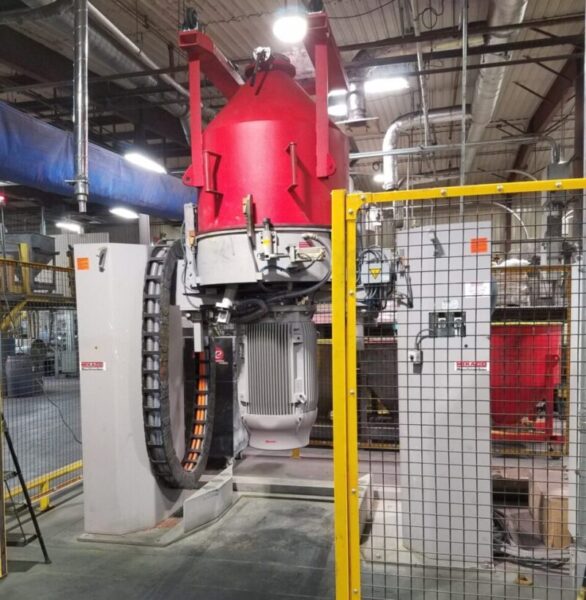Batching in Mixing Containers

Sterling Systems & Controls, Inc. has provided a custom-engineered ingredient batching system featuring the collection of ingredient batches in mixing containers. This includes three (3) transfer/mixing scale carts (each a different size capacity) with the structural frame, two (2) single scale HMI control panels with Allen-Bradley PanelView Plus operator interface terminals (one located at each end of the system), two (2) VFD (variable frequency drive) electrical control panels (one located at each end of the system), and one (1) common CompactLogix PLC system panel. The system utilizes eight (8) ingredient feeders and bins for batching ingredients via gain-in-weight. The automation system provided by Sterling Systems & Controls, automates and controls the batching process by operating the two-stage feeders as required. The “mixing containers,” when filled with a completed batch, will be moved directly to the “container mixer” for mixing.
Operation
Two (2) mixing containers on their respective transfer/scale carts start their travel during the batching process from points at opposite ends of the system from each other. Once the first cart that begins its travel completes its collection of batched ingredients, including automatic and semi-automatic hand-adds, the second cart is automatically controlled to begin its travel and then collect its ingredients. When a cart completes its batching cycle it is then manually removed and brought to the mixer where it is connected and the mixing process begins. Once mixing is complete, the cart’s contents are emptied downstream in the overall process and the cart is returned to the ingredient filling system for the next batch. This system provides an expandable solution for automatically batching formulas with multiple dry ingredients. The system indexes the mixing containers to the proper locations, automatically controls the feeders, and weighs each ingredient into the mixing container in a gain-in-weight fashion.
While processing instructions to batch a specific formula, the automation controls will provide equipment instructions to automatically position the traveling mixing containers and dispense ingredients. For example, assume that a batch of “Example Formula #1” will be run on Scale Cart #1 (recall from the above paragraphs that two (2) scale carts [a mixing container is attached to the scale cart by the operator before beginning a batch] start their travel during a batching process). It is assumed that all data has been entered previously and that all equipment is in automatic mode, and the system is idle and ready to process a batch command.
- Three tote sizes (300 Liter, 600 Liter, & 1,000 Liter in this example) can be filled in this process. The operator ensures the appropriate tote dust hood is moved into position before manually placing the totes onto the traveling automated scale carts. The dust hood allows the dust collection system to ensure there is not an unacceptable amount of dust created in the environment during the batching process.
- When loading a tote, the operator will push the mixing container (tote) all the way forward where the automatic pneumatic locking device will engage the bottom of the back cross-brace of the tote. This attaches the tote (mixing container) to the traveling mechanism that will position the mixing container under the correct ingredient feeder.
- The operator goes to the PanelView at the appropriate HMI control panel and selects the formula (there is one control panel at each end of the system).
- The operator selects the proper mixing container size on the HMI to inform the system which size container to expect.
- The operator will press the Start pushbutton on the HMI control panel.
- The system will evaluate the gross weight of the Mixing Container on the scale cart and compare it to the Empty Container’s minimum and maximum weights.
- The system goes through the automatic indexing of the mixing container and feeding of ingredients to create a batch.
- Hand-adds are added at the end of the automatic batching sequence and the mixing container, with the completed batch, is moved to the mixer by the operator.
The video shown here illustrates the mixing container indexing and filling with ingredients. The isometric illustration in the video shows the entire system with the Mixing Container scale carts, HMI panel and VFD electrical panel at each end of the batching system.